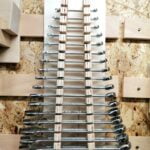Introduction
Woodworking without sandpaper has been done since the dawn of humanity. There are several methods that can be used to get a smooth finish without having to use sandpaper. Some of these include using machinery, scraping tools and files, using chemical finishes, and even using natural items such as lemon juice or cork dust.
In ancient times, it is likely people used tools like hammerstones and adzes in the place of sandpaper; these were handy for creating coarse-grained surfaces which could then be scraped down with a small tool or piece of cloth. Human ingenuity was also utilized to make chemical solutions out of materials such as bark or plants to give wood surfaces a smoother finish.
In more recent centuries, various types of furniture were crafted by highly skilled artisans pushing their skills further with each successive design. In furniture making during the 17th – 19th century both hand and machine tools were used along side abrasives like pumice stone for smoothing wood finishes. In some cases animal hide glue was heated and strained into a bag and rubbed against wood grain in order to smooth out finer details in cabinetry work.
Sandpaper didn’t become widely used until very recently when production techniques made their application easier across the mass market; even today there are still fine cabinet makers who prefer working without sand paper in favor off other traditional techniques to get perfect results on their work.
Creative Benefits of Sandless Woodworking
Sandless woodworking is a great alternative to traditional woodworking methods that involve sandpaper. In this technique, instead of using abrasive materials such as sandpaper, you use tools like rasps and files to create a smooth finish. This method has many benefits and can save you time and money when working with wood. One benefit is the reduction in noise and mess. Sanding your project creates sawdust which can easily make the surrounding environment uncomfortable for you or others if inhaled. Additionally, it is much quieter than sanding, so you don’t have to worry about disturbing anyone who is around while you are working on your project. Another advantage is that it requires less preparation time because you don’t have to spend time preparing the surface before beginning to work on it. You will also save money because you won’t need to buy specialty sandpapers that often do not perform very well unless they are specifically designed for certain projects or materials. Lastly, it provides an end-product that looks much more exceptional as this method produces less dust nibs than sandpaper does. Overall, sandless woodworking provides unique benefits and should be considered when taking on any kind of woodworking project!
Setting Up and Preparing
To complete woodworking projects without sandpaper, you will need a few basic tools, such as a saw, drill, chisels, and power grinder. Also important are some additional materials, such as sharpening stones or diamond-encrusted files for refining the details of your project. For different types of woods and projects, different materials will be required. It is essential to ensure you have all the necessary tools and materials before beginning any woodworking work. Be sure to have every tool that may be needed to complete the project – having extra supplies can also be helpful in case something goes wrong or you change your mind on a design feature. Additionally, always wear safety glasses and protective gloves while handling any sharp tools or power equipment which can be dangerous if handled incorrectly. And finally, practice proper safety practices when working with these items to avoid injury. Taking these steps ahead of time will help ensure your project runs smoothly from start to finish!
Working with Alternative Abrasive Materials
One of the great secrets many woodworkers don’t know is that sandpaper isn’t the only material you can use to achieve a smooth finish. It’s possible to use alternative materials such as steel wool and cork instead.
Steel wool is available in several grades, from superfine (0000) to very coarse (4/0). To use it, start with a gentle grade for light sanding and make progressively finer passes until your desired finish has been achieved. Some like to spin the steel wool on their finger for more control when working with curved shapes. It’s important to remember that steel wool will leave small particles behind, so it’s best used on the underside or inside of projects where those particles won’t be visible.
Cork is a highly abrasive material which yields an ultra-smooth surface quickly after only a few rubs. The use of cork eliminates the need for frequent changing of paper or cloth discs because it retains its texture longer than traditional abrasives. In addition, it doesn’t create dust or debris which can cause clogging of other materials and machines when sanding wood edges. For large surfaces, apply a protective coating like polyurethane first before using cork in order to prevent your surface from becoming too smooth or shiny over time.
Overcoming Uneven Surfaces
Sandpaper has been a mainstay in woodworking for centuries, and is necessary for removing uneven surfaces and other imperfections from furniture and other wooden objects. However, sandpaper isn’t always the best solution for every project- sometimes it’s possible to get the desired results without relying on sandpaper at all. Here are some creative solutions for how to achieve sandless woodworking.
One great alternative is to use a technique called scraping. A scraper consists of a thin blade made of steel, brass or plastic, mounted on a handle. When used properly, it can be effective at taking off small imperfections from surfaces, as well as smoothing them out even further than sandpaper can. Scrapers come in different sizes and shapes which makes them useful for both precision and large-scale scraping jobs.
Another tool that can be used instead of sandpaper is an orbital sander. This type of sander works by vibrating the surface back and forth using rotary movement rather than just grinding it away with abrasive materials like most typical Sanders do. Orbital Sanders provide fast and efficient results with less effort involved compared to manual sanding techniques such as hand planing or rubbing down pieces with abrasive cloths. They also tend to leave a much smoother finish than traditional sanders would do when used on delicate surfaces like veneers or particle boards.
One more tool that you might want to consider if you’re looking to avoid using any kind of sandpaper at all is an oscillating multi-tool (OMT). OMTs have become very popular lately due to their versatility; they are basically compact power tools that allow you to cut, grind, polish and scrape with various attachments depending on what type of have job you need done. Thanks to its versatility, this handy little tool can take care of many tedious tasks normally done by hand when working with wood including shaping edges and smoothing out uneven surfaces quickly and efficiently- all without resorting to the use of sandpaper at any point!
Finishing Touches
Using sandpaper is a great way to add the professional element to any woodworking project, but for many woodworkers this tool can be difficult to access. Fortunately, there are other ways that you can finish your woodwork and achieve a flawless finish without having to resort to sandpaper.
One of the easiest finishing tools is steel wool. Steel wool comes in various grades from extra fine (0000) to rough (4/0) so you should select the one that works best with whatever type of wood you’re working on. Simply rub the steel wool on the surface of your project by following the grain of the wood until it’s smooth and even. Steel wool will also create a low gloss finish when combined with oil or wax.
Another method you can use instead of sandpaper is a pumice stone or piece of burlap. These materials provide gentle abrasion that helps to create an even layer on the surface of your project while still softening sharp edges and imperfections in knots or minor dents or divots. Pumice stones are great for high-gloss finishes as they leave behind a smooth and polished look after just a few passes. As for burlap, its tightly woven fibres create more friction which results in creating satin duller finishes if desired.
Finally, for those looking for precise control during their woodworking projects, precision hand tools like chisels, card scrapers and rasps come in handy here too! Be sure to use caution; however as these tools require careful safety measures so as not cause any damage or injury during use. When correctly used, these tools allow for precise work such as creating smoother transitions between two different surfaces or carving out detailed shapes with sharp edges which cannot otherwise be achieved when using sandpaper alone
Securing Your Woodwork
Woodworking without sandpaper can seem like a daunting prospect, but it does not have to be. With a few simple tips, you can secure your woodworking projects for years of enjoyment and use.
One helpful tip is to use the right type of wood glue when joining pieces together. Wood glue bonds permanently and dries quickly, preventing the pieces from separating over time while still allowing them to move slightly with the natural expansion and contraction of the wood. When attaching two surfaces together make sure they are clean and free of any dust before applying your adhesive. Allow ample time for the glue to set properly before you proceed with additional work on your project.
You may also want to consider using a finishing oil or wax as protective coatings after assembly is complete. Finishing oils, such as tung oil or linseed, penetrate deep into finished surfaces and form an invisible barrier that provides protection yet is still able to enhance the visual beauty of your wood. Waxing is another option for finish protection that can add an extra layer of shine and luster but does not penetrate as deeply as oils do.
Carefully inspected dovetail joints provide excellent strength for wooden projects without needing fasteners like screws or nails. Dovetails involve an interlocking series of “fingers” that fit snugly against each other when attached correctly, making strong and attractive joints without sandpaper or other abrasives.
Finally, if you must use fasteners during construction, predrilling holes in appropriate spots will allow you to drive screws or nails in securely while creating minimal damage possible to the ornamental surface of your project. For intricate fastening applications such as those used in furniture building, it may be best to leave the work up to a professional carpenter with experience in working with fine joinery techniques or specialized tools like pocket hole jigs or biscuits joiners.
Final Thoughts
Sandless woodworking has the potential to revolutionize the way we approach traditional woodworking. By completely eliminating the need for sandpaper, it offers many advantages for DIYers and furniture makers alike. For one, sandless woodworking requires fewer tools and supplies than sandpaper-based methods, making it easier and more affordable to get started. Additionally, sandless woodworking results in smoother surface finishes that can easily be touched up with a bit of wax and elbow grease. The end product is often much better looking than items that have been treated with sandpaper. Ultimately, it can save time and money while providing superior results in comparison to traditional methods. If you’re ready to experience the benefits of sandless woodworking, consider investing in specialized tools like power planers and orbital sanders, which are designed specifically for smoothing down surfaces without using any abrasives at all. With a little practice and patience, you’ll be able to achieve beautiful results quickly and easily every time!

Hi everyone! I’m a woodworker and blogger, and this is my woodworking blog. In my blog, I share tips and tricks for woodworkers of all skill levels, as well as project ideas that you can try yourself.





